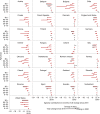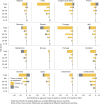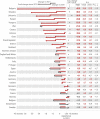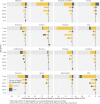Life expectancy changes since COVID-19
- PMID: 36253520
- PMCID: PMC9755047
- DOI: 10.1038/s41562-022-01450-3
Life expectancy changes since COVID-19
Abstract
The COVID-19 pandemic triggered an unprecedented rise in mortality that translated into life expectancy losses around the world, with only a few exceptions. We estimate life expectancy changes in 29 countries since 2020 (including most of Europe, the United States and Chile), attribute them to mortality changes by age group and compare them with historic life expectancy shocks. Our results show divergence in mortality impacts of the pandemic in 2021. While countries in western Europe experienced bounce backs from life expectancy losses of 2020, eastern Europe and the United States witnessed sustained and substantial life expectancy deficits. Life expectancy deficits during fall/winter 2021 among people ages 60+ and <60 were negatively correlated with measures of vaccination uptake across countries (r60+ = -0.86; two-tailed P < 0.001; 95% confidence interval, -0.94 to -0.69; r<60 = -0.74; two-tailed P < 0.001; 95% confidence interval, -0.88 to -0.46). In contrast to 2020, the age profile of excess mortality in 2021 was younger, with those in under-80 age groups contributing more to life expectancy losses. However, even in 2021, registered COVID-19 deaths continued to account for most life expectancy losses.
© 2022. The Author(s).
Conflict of interest statement
The authors declare no competing interests.
Figures













References
-
- Riley JC. Estimates of regional and global life expectancy, 1800–2001. Popul. Dev. Rev. 2005;31:537–543. doi: 10.1111/j.1728-4457.2005.00083.x. - DOI
-
- Raleigh, V. S. Trends in Life Expectancy in EU and Other OECD Countries: Why Are Improvements Slowing? OECD Health Working Papers (OECD, 2019); 10.1787/223159ab-en
Publication types
MeSH terms
LinkOut - more resources
Full Text Sources
Medical

